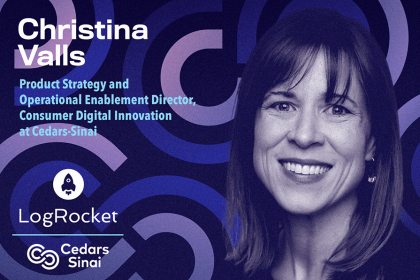Sowmya Sundararagavan is Senior Director of Product and Head of ITAM SaaS solutions at Freshworks, a people-first AI service software. She began her illustrious career as a fervent technologist. She worked at numerous financial institutions such as Goldman Sachs and JPMorgan, where she developed long-term product vision and roadmap and was instrumental in delivering cutting-edge enterprise products for Wall Street customers. Soon, she transitioned into the product world. Before her current role at Freshworks, she served in various product management and leadership roles at Morgan Stanley, VMWare, and Flexera.

In our conversation, Sowmya shares best practices for maintaining a strong long-term vision while also remaining flexible. She talks about the role of data in shaping long-term product strategy, as well as how she encourages her teams to always continue learning and advancing their careers.
Having geographically dispersed team members requires a combination of clear strategies, effective tools, and strong leadership. I recommend a few strategies to maintain effective collaboration and communication. First, you need to establish clear values and norms. Ensure all your team members understand the core values, expectations, and goals of the team, because this sets a strong foundation for collaboration, even when they are working from different locations.
When I say strong team culture, inclusivity is part of that. That means creating an environment where each team member feels valued, despite the physical distance. It also means celebrating diversity and ensuring that remote employees are not left out of discussions or team-building activities. I also recommend regular and structured check-ins, like 1:1s and daily or weekly stand-ups.
In terms of communication channels, no tool’s perfect and they all serve different purposes. The most important thing is setting expectations for responsiveness. You need to define clear guidelines on when team members are expected to be available and how quickly they should respond to different scenarios. As product leaders, you might do customer communications, which takes priority over some other work that you are doing. It’s essential to set that expectation. As product leaders, we need to have those goals clearly defined, and that reduces any ambiguity and delays.
I believe in people over process. At the end of the day, if your people are collaborating and working well, you set their goals, and you speak with them regularly, tools come secondary.
When people are in different locations, it’s important to encourage autonomy and accountability. You cannot micromanage people — you need to empower team members and track progress through outcomes, not by hours. The focus should be on measuring results because that encourages flexibility and reduces micromanagement, especially in dispersed teams.
Further, I emphasize prioritizing mental health and well-being. Leverage technology to overcome challenges and provide clear leadership and vision. Be very transparent about your organizational goals and challenges. Transparency from a leadership perspective is key because that fosters trust and creates alignment across different locations. And you can only do that by leading by example.
As a product leader, I try to stay curious about emerging technologies and demonstrate my commitment to learning. I do learning courses and get certifications so that I can share insights and encourage the team then to follow suit. Then, as a company, we provide a lot of learning resources. We have online courses and certifications, and encourage our team members to expense courses on Coursera, edX, Udacity, etc.
We also do a lot of books and white paper discussions to share learnings among the group. Other teams share analyst reports and market insights. For example, there are some key books in emerging tech, which I recommend everyone read. One is Deep Learning by Ian Goodfellow, on AI, as well as Blockchain Revolution by Don Tapscott, and Data Science for Business by Foster Provost. These are go-to books.
I also encourage team members to attend tech conferences, like Women in Tech. Virtual events make them accessible to remote teams as well. Overall, I think continued learning should be embedded in a regular work schedule. The idea is to create an ecosystem where learning is integrated into the culture, offer structured resources, and encourage practical experience.
Having a strong understanding of the market, your customers, and technical and business acumen is crucial. That helps you effectively guide product development, make informed decisions, and drive success for the product and company. In terms of crucial skills, there should always be the right balance between technical expertise and business acumen.
Take technical skills for example. If you’re in a technical product manager role, you might need to know some of the basics of software development. You don’t need to be a coding expert, but understanding basic programming concepts will help you communicate with development teams and understand technical limitations. It’ll also help you make informed decisions for your customers.
Another important skill set is data analytics and metrics. Product managers should know and be proficient in working with data to measure the success of a product. This means familiarity with product analytics, such as how many users are using your platform, defining key performance indicators, analyzing user behavior, and more. It’s important to be able to make data-driven decisions — data is at the crux of everything.
I encourage continuous learning, frequent feedback loops, and a collaborative, open environment focused on high-level strategic understanding. Business objectives should come first, and they should be prioritized based on impact. You could use tools like the impact versus effort matrix or RICE, and be able to make trade-offs based on market demand and business value.
Further, empower your PMs to own their own product roadmaps. Though it’s a collaborative road map creation, you need to know how to plan the scenarios so that PMs can trade-off between technical complexity and business value.
You can use tools to bridge the gap between business and technicality. You can encourage hands-on involvement in product development by shadowing engineers. Many product managers do that — they get involved in hackathons and product prototyping. And all of those things. It’s important that you foster an environment for continuous learning and provide opportunities for cross-functional collaboration.
When I consider long-term product vision, there needs to be a balance between setting long-term direction and ensuring that there is adaptability to evolving market dynamics. Customer needs, technological advancements, and changing markets are all very important. Being customer-centric is the key focus here, which means understanding evolving customer needs, ensuring that the vision centers around solving customer pain points, and delivering the value proposition. As customer needs and behaviors shift, the product vision should be able to adapt. Continuous customer feedback and anticipating future needs are important here.
Second is market and competitive landscape awareness. You should be able to track industry trends and have a flexible positioning mechanism. Stay attuned to changes in the market, shifts in competitors, industry innovations, and more. That awareness can help refine the product vision and help you account for future opportunities. The vision should be focused on delivering value while remaining open to pivots or adjustments.
Third is the technological landscape and innovation. You need to incorporate emerging technologies and be scalable and adaptable to future technological development. Otherwise, you risk becoming obsolete from shifts in technology. Do research and partnerships with thought leaders, tech conferences, and customer advisory boards. And always align with the organization’s broader vision — that’s where your strategic objectives lie.
I think the best method is to have an outcome-based vision and a phased evolution. By establishing clear yet adaptable objectives, you can frame the product vision around a desired outcome. For example, you can say, “I want to improve customer satisfaction. I want to enable greater productivity. I want to democratize access to X information, rather than specific features or technology.” That provides flexibility on how those outcomes are achieved over time. With a phased evolution, you can break down the long-term vision into phases, each with its own milestones and focus area, and have regular assessments.
Regular review and refinement are important. The product roadmap should be a living document that can adapt to changing realities. Be agile in execution and focus on value-propped deliverables to test any new ideas with actual users.
Customer feedback plays a critical role in shaping your long-term product strategy. It helps ensure that the product evolves in a way that aligns with market demands, as well as creates customer loyalty and drives your business success.
First, always validate your product direction. When you are refining the product vision, customer feedback will help you validate the foundational assumption behind the product vision. As the market and customer needs shift, feedback always ensures that the product continues to solve any relevant problems.
Customer feedback also helps you identify unmet needs and market gaps. Sometimes, you see new opportunities or innovative insights by actively listening to customers. You might even identify gaps in the market that you previously did not consider. Customers often provide ideas for new features, services, or improvements. While not every suggestion is feasible, capturing and analyzing the feedback can spark innovation and keep your product competitive.
I also think customer feedback enhances your data-driven decision-making capability. You ensure that resources are spent on the right features and are building something that they truly value. This also builds empathy because you engage with the customer through that feedback channel. You can measure this success through metrics like net promoter score, customer satisfaction surveys, or user engagement data.
I had a situation where our product took a 45- or 50-degree turn from where we were. Some of our customers were deeply technical and involved in learning the market, and we were at a very nascent stage of the product. Our customer advisory board helped us move the needle for that particular feature because they gave us feedback that, if we had put it in the market, we only would’ve gotten 10 months later. We were able to mitigate risks and hit the market faster by getting feedback from our customer advisory board, and our customers loved it.
When you craft a long-term product strategy, having a comprehensive and data-driven approach to analysis is crucial. You want to ensure that the product’s alignment with market needs, competitive forces, and business objectives is key.
I think that SWOT, customer segmentation, and market sizing all play vital roles in shaping the strategy. Data’s role is also key here. When you gather data from customer reviews, surveys, and support tickets to identify the strengths and weaknesses in your product offering, that’s invaluable. You can also use performance metrics like product usage, churn rates, and customer acquisition cost to identify areas of strength and weakness. Social listening tools can surface external opportunities and threats, like new technologies or changing customer behaviors. From there, you can refine the value proposition.
Further, competitive analysis is equally important to identify where your differentiation lies. You can compare in terms of functionality and customer experience, and also the value they deliver for the price they charge. That also helps you with market share and positioning. Customer segmentation also is necessary to prioritize the features of your market strategies for different customer groups.
Last is the total addressable market, serviceable addressable market, and serviceable obtainable market. You should really look at industry reports, customer insights, and trends and projections to understand that. That’s how you’re going to estimate the true total potential revenue of your product, and what that could generate.
Overall, data plays a pivotal role in shaping these decisions, and by continuously integrating these data and insights from this analysis, you can create a product strategy that is adaptable and customer-focused. That will ultimately help you achieve long-term success.
LogRocket identifies friction points in the user experience so you can make informed decisions about product and design changes that must happen to hit your goals.
With LogRocket, you can understand the scope of the issues affecting your product and prioritize the changes that need to be made. LogRocket simplifies workflows by allowing Engineering, Product, UX, and Design teams to work from the same data as you, eliminating any confusion about what needs to be done.
Get your teams on the same page — try LogRocket today.
Want to get sent new PM Leadership Spotlights when they come out?

Christina Valls shares how her teams have transformed digital experiences at Cedars-Sinai, including building a digital scheduling platform.

Red-teaming reveals how AI fails at scale. Learn to embed adversarial testing into your sprints before your product becomes a headline.

Cory Bishop talks about the role of human-centered design and empathy in Bubble’s no-code AI development product.

Learn how to reduce mobile friction, boost UX, and drive engagement with practical, data-driven strategies for product managers.